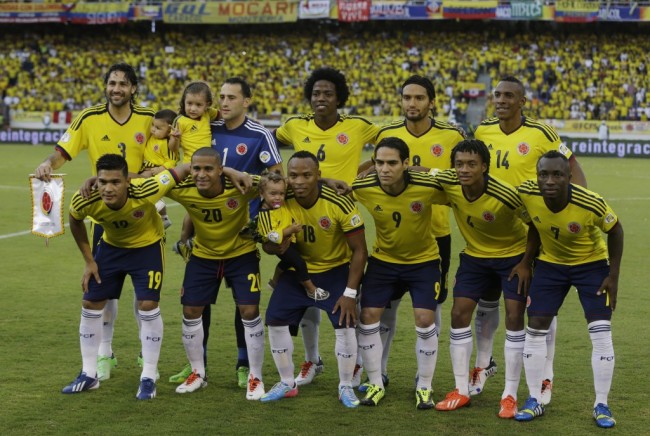Because this is a World Cup year, I have decided to countdown to the tournament by providing a short soccer/fitness related preview of each of the 32 participating nations. In this installment, I will look at Colombia, slight favorites in wide open Group C, which also contains Greece, Ivory Coast, and Japan. Colombia play their first match against Greece on June 14th.
The Colombians had a strong qualifying campaign, finishing a close 2nd in South America, only 2 points behind Argentina. Much of their success was due to the impressive play of their star forward, Radamel Falcao, who scored 9 goals in 16 qualification matches. Unfortunately, Falcao suffered a tear in his anterior cruciate ligament (ACL) on January 22nd while playing with club team Monaco in the Coupe De France, and his recovery in time for the World Cup in June is doubtful. He did have a successful surgery in late January, however, and has been training hard for the past 3 months in the hopes of recovering in time for his nation’s first match on June 14th.
Injury to the ACL is a very common occurrence among soccer players. The valgus forces (forces that rotate the knee inwards) generated on the knee during tackling/challenging for the ball, as well as in various cutting/pivoting movements, combined with high speeds, make the ACL (the ligament that prevents excessive inward rotation of the knee) particularly susceptible to injury in soccer. While completing my 4-year undergraduate degree, I worked as a chiropractor’s assistant to Dr. Robert Gringmuth at the Sports Injury and Rehabilitation Centre, health care providers to the Ontario Provincial and National Training Centre male and female teams. Over that 4-year time span I saw and worked with, on average, between 10-20 youth soccer players (aged of 12-18) with ACL injuries and tears per year. While tearing of knee ligaments during forceful tackles and/or challenges for the ball in soccer may not always be avoidable, there are many other simple measures soccer players can take to prevent ACL injuries. Among them are:
- performing proper warm-ups, including multi-directional movements, dynamic stretches, strength exercises, and plyometrics, prior to training and playing
- strengthening of the hamstring muscles (muscles on the back of the thigh) that prevent excess loading on the quadriceps (front of the thigh) during running and jumping
- strengthening of the hip external rotators, which help to prevent excess inwards rotation of the knee during cutting and pivoting movements
Recovering from an ACL tear – and subsequent surgical repair – is a long process that requires a lot of mobility/flexibility and strength training, and in the later stages of rehabilitation, speed, power, and aerobic endurance training to regain match fitness. Athletes recovering from ACL surgery must be both patient so that they avoid over-training and re-injury, as well as aggressive in their push to regain mobility and strength in the knee. They must also learn to “trust” their surgically repaired knee, so that they can go back into the sport and perform all the required movements with confidence and without unnecessary fear. On average, elite level soccer players will require 5-6 months of rehabilitation following ACL surgery before they can return to play. Some players, however, have made full recoveries in as little as 4 1/2 months post-operation.
Falcao is a professional athlete who trains with top level club Monaco in the French Ligue Un. He has access to the best physicians, sports scientists, fitness coaches and athletic therapists money can buy. Hopefully for him, and for Colombia, he will be able to recover in time to help his team. We will have to wait and see what happens in 2 months’ time.
I’d love to hear your thoughts about this. Drop me a line here to get the conversation started.


Leave A Comment